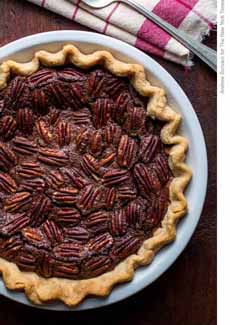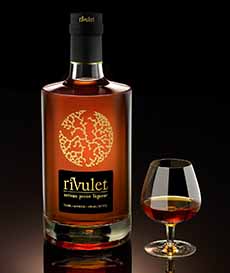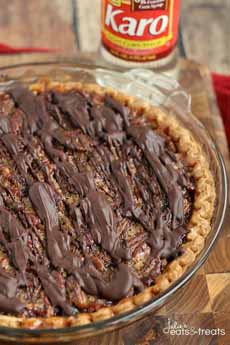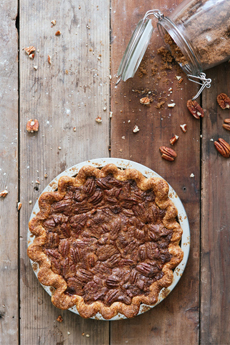Chocolate Pecan Pie Recipe & The History Of Pecans
|
August 20th is National Chocolate Pecan Pie Day (April is National Pecan Month, April 14th is National Pecan Day, July 12th is National Pecan Pie Day, and here are the year’s 38 nut holidays—and the year’s 31 pie holidays.
Our only question regarding this delicious pie: Why eat heavy pecan pie during the summer—not to mention add rich chocolate to it—when there are so many seasonal, ephemeral berries and stone fruits to turn into pies? We will not attempt to answer why people establish food holidays in questionable seasons. So if you’re not in the mood for a slice today, keep this recipe from Melissa Clark of The New York Times for the fall, when a hearty, dense pie is just the thing to stick to the ribs. Don’t be tempted to substitute milk chocolate or semisweet chocolate chips. Pecan pie is sweet enough. The bittersweet chocolate specified here (70% cacao or higher) is just the thing: intense chocolate flavor without a lot of added sugar. Two tablespoons of bourbon add just a hint of flavor. Try it, and if you want to add more next time—or some pecan/praline liqueur—go for it (photo #4). It also is a delicious after-dinner drink to serve with the pie. Ms. Clark’s pie has a conventional pie crust. You can also use a chocolate wafer crumb crust. Pecan pie is traditionally garnished with whipped cream. Given the sweetness of the pie, a dollop of of unsweetened whipped cream, crème fraîche or sour cream is just right. On the other hand, if you have a serious sweet tooth and want to gild the lily: Drizzle chocolate or caramel (preferably salted caramel) sauce over the top of the pie. Don’t like to bake? The easy way out is this excellent chocolate pecan pie filling from San Saba Pecan, spooned into a store-bought crust. > Below: the history of pecan pie and the pecan itself. > Below: the history of the pecan itself. > The history of pie a la mode. > The different types of pie: a photo glossary. For The Crust 1. MAKE the crust: In a food processor, pulse together the flour and salt. Add the butter and pulse until the mixture forms chickpea-size pieces. Add the ice water 1 tablespoon at a time, and pulse until the dough just comes together. It should be moist but not wet. 2. GATHER the dough into a ball on a lightly floured surface, and flatten it into a disk with the heel of your hand. Cover tightly with plastic wrap and refrigerate for at least 1 hour, and up to 2 days. 3. REMOVE the plastic wrap and roll out the dough to a 12-inch circle, on a lightly floured surface. Transfer the crust to a 9-inch pie plate. Fold over any excess dough, then the crimp edges. Prick the crust all over with a fork. Chill the crust for 30 minutes. While the dough chills… |
[3] A pecan tree. If you live in warmer zones (6 through 9), you can grow your own (photo courtesy Perfect Plants Nursery). You can also grow the trees in zone 5, but they won’t bear nuts.
|
|
|
4. HEAT the oven to 375°F. Line the chilled crust with aluminum foil and fill with pie weights or dried beans. Bake for 25 minutes; then remove the foil and bake until it’s a very pale golden color, 5 to 10 minutes longer. 5. REDUCE the oven temperature to 350°F. Spread the pecans on a rimmed baking sheet and toast until fragrant, 8 to 10 minutes, shaking the pan occasionally. Cool. 6. MAKE the filling: In a small saucepan over low heat, melt the butter and chocolate, stirring until smooth. Cool. 7. WHISK together in a large bowl the cooled chocolate-butter mixture, corn syrup, eggs, sugar, cocoa powder, bourbon, and salt. Pour the mixture into the prepared crust. Arrange pecans over the filling. 8. TRANSFER to a large rimmed baking sheet and bake until the filling is just set when the pan is jiggled, 30 to 40 minutes. Remove the pie from the oven and cool completely on a wire rack before serving. |
||
|
|
PECAN PIE HISTORY It seems difficult to believe given the long history of pecan trees in the Colonial South*; but the pecan pie recipe we know, pecans on a brown sugar base, is a 20th-century invention. No recipes have been found dating to earlier than 1925. According to FoodTimeline.com, The Fannie Farmer Cookbook and The Joy of Cooking did not include pecan pie recipes before 1940. While some sources claim that early French settlers in New Orleans invented pecan pie after encountering the nuts (which they called pacane, after the Native American paka·n), food historians have not been able to trace the dish’s origin prior to 1925. That doesn’t mean pecan pie didn’t exist, only that there is no record to prove it. Popular national cookbooks such as The Joy of Cooking and The Fannie Farmer Cookbook did not include the recipe prior to 1940. Yes, there were pies made with pecans; they just weren’t pecan pies as we know them or called “pecan pie.” References dating to 1886 and 1914 added the nuts to a milk-based custard. Then came a breakthrough on the road to modern pecan pie. In 1913, Mrs. Vesta Harrison of Fort Worth, then an unmarried teenager taking a cooking course, won a national competition with her Texas Pecan Pie, made with a filling of sorghum. She said the recipe for this pecan pie came to her in a dream. When she told the teacher at her cooking school, a Mrs. Chitwood of Chicago, that she was going to make a pecan pie, the teacher exclaimed “There is no such thing!” The future Mrs. Harrison, interviewed later in life, said she responded, “By gollies, I don’t know how, but I’m going to mess up something making a pecan pie.” Mrs. Chitwood sent the recipe to the contest in Washington, where it won first prize. So even if there already was a syrup-based pecan pie somewhere in the U.S., it was unknown in Texas, Chicago or Washington [source]. Following the introduction of the sorghum-based pecan pie, versions were made with molasses. Enter Karo Syrup & The Modern Pecan Pie The modern pecan pie was born with the introduction of Karo Syrup, in 1902. One of the earliest recipes to substitute the sorghum or molasses with Karo corn syrup was by Mrs. Frank Herring, published in the Sallislaw, Oklahoma Democrat American on February 19, 1931: |
|
|
3 eggs, 1 cup Karo (blue label), 4 tablespoons corn meal, 1/2 cup sugar, 1/2 cup chopped pecans or less if desired, pastry. Method: Beat whole eggs slightly, add Karo, corn meal, sugar and melted butter, then stir all thoroughly. Line pie tin with flaky pastry and fill generously with mixture. Sprinkle chopped pecans on top, bake in moderate oven until well set when slightly shaken [source]. Printed on the bottle label, the makers of Karo Syrup popularized the recipe that many people use today. It has similar ingredients to Mrs. Herring’s recipe, minus the corn meal and adding vanilla extract. It doubles the amount of Karo syrup and sugar and triples the pecans. Here’s the recipe. The Karo website says that the recipe was created in the 1930s by the wife of a senior sales executive. When the pie appeared on the bottle label and in magazines, it was known as Karo Pecan Pie. This unnamed executive wife may well have seen, and adapted, Mrs. Herring’s 1931 recipe. The rest is sweet history; although as soon as we have time, we’re going back to make the Karo pie using the smaller amounts of sugars in the Herring recipe. When a scoop of vanilla ice cream is needed to cut the sweetness of a pie, you know it’s too sweet. The pecan, Carya illinoinensis (photo #3), is a member of the Juglandaceae family, known as the walnut family of trees. The trees are native to the Americas, Eurasia and Southeast Asia. The family also includes the hickory, about 16 species of which are native to the Americas. In America, the tree originated in central and eastern North America and in the river valleys of Mexico*. It evolved in North America millions of years ago. The name “pecan” is a word of Algonquin origin that describes “all nuts requiring a stone to crack” or “a nut too hard to crack by hand.” Long before Europeans arrived, pecans were widely consumed and traded by Native Americans. Nuts were an excellent food product for a pre-agricultural society, easy to harvest and store (and an excellent source of protein and other nutrients). The first Europeans to come into contact with pecans were 16th-century Spanish explorers in what is now Mexico, Texas, and Louisiana. They called the pecan, nuez de la arruga, which means “wrinkle nut,” due to the deep lines resembling wrinkles in the nutmeats (photo #2). The explorers brought the pecan to Europe, Asia, and Africa beginning in the 16th century. In the 17th century, both native Americans and settlers began seeing pecan trees as a potential source of income. Pecans could be traded and were integral dietary components, especially during times of difficult harvests. Some very influential people, including George Washington, were early proponents of pecan farming [source]. Thomas Jefferson planted pecan trees, Carya illinoinensis (“Illinois nuts”) in his nut orchard at Monticello, in Virginia. George Washington wrote in his journal that Jefferson gave him “Illinois nuts” to grow at Mount Vernon. Pecan Trivia The U.S. produces more than 300 million pounds of pecans annually. In recent years pecan farmers have been planting thousands of additional acres of pecan orchards, so production is steadily increasing [source]. *Currently, the largest pecan-producing states are, in order of tonnage: Georgia, Texas, New Mexico, Arizona, Louisiana, and Oklahoma. Pecans are grown coast to coast along the southern tier of the United States. The largest pecan orchard is Stahmann Farms in New Mexico. |
||








